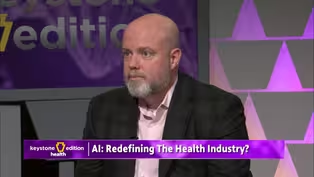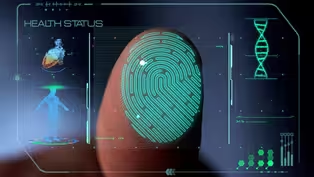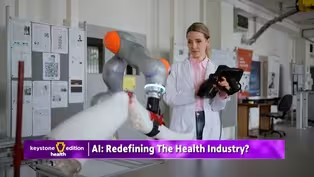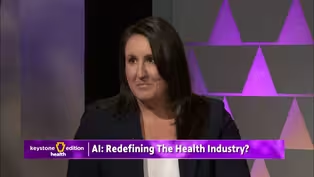Keystone Edition
The Future of AI in Healthcare
Clip: 11/18/2024 | 8m 31sVideo has Closed Captions
Future advancements aim to integrate AI further into healthcare,
Robotic systems like the Mako robot have been in use since 2013, enhancing surgical precision and efficiency. Everyday AI, like chatbots and automated systems, is familiar yet underrecognized. Tools like Dactyl streamline documentation, improve accuracy, and save time for patient care. Future advancements aim to integrate AI further into healthcare, boosting efficiency, quality, and satisfaction
Problems playing video? | Closed Captioning Feedback
Problems playing video? | Closed Captioning Feedback
Keystone Edition is a local public television program presented by WVIA
Keystone Edition
The Future of AI in Healthcare
Clip: 11/18/2024 | 8m 31sVideo has Closed Captions
Robotic systems like the Mako robot have been in use since 2013, enhancing surgical precision and efficiency. Everyday AI, like chatbots and automated systems, is familiar yet underrecognized. Tools like Dactyl streamline documentation, improve accuracy, and save time for patient care. Future advancements aim to integrate AI further into healthcare, boosting efficiency, quality, and satisfaction
Problems playing video? | Closed Captioning Feedback
How to Watch Keystone Edition
Keystone Edition is available to stream on pbs.org and the free PBS App, available on iPhone, Apple TV, Android TV, Android smartphones, Amazon Fire TV, Amazon Fire Tablet, Roku, Samsung Smart TV, and Vizio.
Providing Support for PBS.org
Learn Moreabout PBS online sponsorship- So a question I have for whoever would like to answer this, obviously we're talking about AI, I feel like the first we started to hear about it was ChatGPT or something of that sort, and kids using it to write papers.
But really this has been around for while.
What are some examples that you could give for people so they understand they've been using this technology already?
I don't know if anyone has thoughts about that.
- I could say for the Mako robot, it's been in use probably since 2013.
- Okay.
- So it's been around even a lot longer than we have, and what we've seen as the applications continue to grow, the ability to use it in different areas in surgery will continue to grow, just even beyond knee and hip replacement.
So it has been around quite a while.
- Okay, and can you give us some scenarios of how AI has helped within the health system?
- Sure- - Through innovation.
- Absolutely, and sure, and just going back a bit around other types of maybe examples we have in our common lives.
Think about making a phone call and not maybe particularly speaking with a human being, but having the interaction to get a job done where it's self-service.
- Oh, like press one, press two.
(laughs) - Exactly, that's an example.
Another example is just interfacing with chatbots, that's a part of this AI spectrum I would say.
Those are common types of examples that we deal with in our everyday life.
And I'm not sure we think of that when we're interacting that as AI, so to speak.
But that is definitely learning and is definitely using data to advance self-service capabilities.
And really at the end of the day, again, going back to why we're doing this, is to enhance the self-service to get the job done maybe quicker, more efficiently, and maybe within the preferences that you want, right, so that's another example.
- Thank you.
Joe, how many physicians do you have using Dactyl right now?
I assume there might be other companies doing something similar.
So should we expect this to be become kind of the norm when we go to see our primary care physician?
- So in total, across the industry, I think we're, you know about, I saw somewhere, it's about like 20,000 physicians are using scribes like us.
For us personally, it's about a couple hundred, we're still a relatively young company.
But that sounds like a big number, a couple, you know, 20, 30,000, but we're still at, you know, about 1 or 2% total market penetration.
And so yeah, I think that this is gonna be a much more widespread thing, especially given the patient experience improvements that we've seen.
- And how do you see adaptation growing?
So are you seeing mostly younger physicians or older physicians using this too?
- Surprisingly, I think we've seen quite a bit of older physicians embrace this, especially because the younger ones already seem like they had a better setup with...
They have, you know, fancy systems on their computer where they're able to type out notes very quickly.
And usually the younger ones have that, and the older ones haven't really had the chance to set those things up yet, or the will to set those things up yet.
And so I think that the older ones have actually seen the most value out of this.
- And how long does it take to set up a system like this?
- For our system, about five minutes.
It depends exactly how deep you want to integrate it with your system.
We integrate with number of health record systems, and so some of that setup may take a few days on our end, but usually physicians can get set up and using it by just making account, and clicking the microphone, and starting to talk.
- So we talked earlier about how many surgeries you tend to do a day.
Do you feel that with the assistive technology you're doing more, or do you use that time to give the patient better quality care since you've kind of shortened things a little and can be more precise?
- Yeah, absolutely.
So it's a little of both, truthfully.
I think that's the advantage in the clinic.
You can spend more time with patients face to face, get more involved in their lives as well too.
You know, I think one of the things I enjoy doing is talking to patients, not just about their knees or hips, just about their life.
So I think that that helps with that, it helps with efficiency in the operating room as well, again, going down to being more precise, more predictable.
So I think yes, on both counts, yeah.
- Thank you.
We talked a little bit about ambient documentation.
Can you tell us a little bit more about that?
- Yeah, it's very similar to what Joe's speaking of, right?
It's, you know, I always take it a step back, right?
And not talking about the actual intervention, but why, right?
We have a workforce shortage, clinicians, nurses, et cetera.
And we're seeing the folks who care for the people who are our number one asset in the organization have burnout and experiencing administrative burden and demand.
So when we think about how we could apply more efficiency and decrease some of the administrative burden, we are piloting ambient documentation, which is a version of ambient listening and very much similar to what Joe was talking about.
So that's really focusing on how we could bring that type of value to the care team.
But I think it's also really important to understand that that patient experience and the type of time that that doctor is spending with the patient in the room is important as well.
So we're hoping to see a lot of patient satisfaction increase over this time as well.
So that's when we're thinking about ambient listening as a very broad umbrella, but that particular use case is what we're calling ambient documentation.
- Got it, got it.
Are you using this with your patients?
- I'm actually not yet.
(chuckles) I do have a lot of different tips and tricks that I use for myself in Epic, which is our main medical record generator.
So I've become pretty good at being able to get my notes done very quickly so that way I can spend the time talking to patients.
- Joe, you talked a little bit earlier about the fact that when these notes are being taken, there could be something that's scribed for the physician that they didn't pick up on before.
Can you give an example about how the technology would work, and maybe find that information for the physician later or highlighted in some way?
- Yeah, so the way our system works is, you know, over the duration of an exam, it is recording everything and then it is transcribing it in real time.
And so every word that the patient says and the doctors say, is transcribed down.
Afterwards, you know, the audio is immediately deleted, but we can keep that transcription around if the provider decides to, and every word, even offhand comments, can get picked up and then we flag them.
So we always have a model running that looks for important things that it might think are relevant to the diagnosis.
And again, you know, many, many words are said, you can have thousands and thousands of words spoken in a long visit, and being able to pick out precise phrases is a really important thing for these physicians.
- So I guess we won't be seeing AI go anywhere, and we can assume that there'll be more applications.
What are you hoping to see in the future, for instance?
- I think generally, we're very excited about the potential.
We're very excited about continuing to find use cases that are attaching to our main strategic priorities of the organization, and, you know, really trying to solve the most pressing challenges of our time within the healthcare organization.
We're proud of the way that our infrastructure is being set up and training and communication, and upskilling our employees in order to be able to kind of participate in that type of future.
I think you're gonna see AI kind of already on the healthcare system side, but also on the health plan side, on the contact center side, on ways that we could maybe predict or anticipate consumers expectations growing, whether it's self-service capabilities, or the ability to anticipate and provide quality.
So I could say that I'm very excited about the future.
Advancements in AI and Robotics in Healthcare
Video has Closed Captions
Clip: 11/18/2024 | 6m 46s | In this segment, panelists discuss advancements in AI and robotics in healthcare. (6m 46s)
AI: Redefining the Health Industry? - Preview
Preview: 11/18/2024 | 30s | Watch Monday, November 18th at 7pm on WVIA TV (30s)
Overview - AI: Redefining the Health Industry
Clip: 11/18/2024 | 59s | AI is improving diagnostic accuracy, personalizing treatments, and enhancing operational efficiency. (59s)
Practical Applications for AI in Healthcare
Clip: 11/18/2024 | 8m 29s | A discussion of AI and Robotics in healthcare (8m 29s)
Providing Support for PBS.org
Learn Moreabout PBS online sponsorship
- News and Public Affairs

Top journalists deliver compelling original analysis of the hour's headlines.

- News and Public Affairs

FRONTLINE is investigative journalism that questions, explains and changes our world.












Support for PBS provided by:
Keystone Edition is a local public television program presented by WVIA



